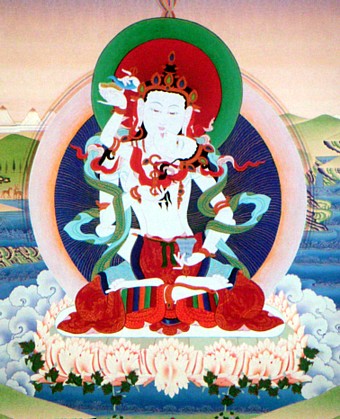Sambhogakaya: Difference between revisions
Jump to navigation
Jump to search
No edit summary |
|||
| Line 4: | Line 4: | ||
[[Sogyal Rinpoche]] writes: | [[Sogyal Rinpoche]] writes: | ||
:Sambhogakaya is the dimension of complete enjoyment, the field of total plenitude, beyond dualistic limitations and beyond space and time.<ref>''[[The Tibetan Book of Living and Dying]]'' revised and updated edition (HarperSanFrancisco and London: Rider, 2002), page 347.</ref> | :Sambhogakaya is the dimension of complete enjoyment, the field of total plenitude, beyond dualistic limitations and beyond space and time.<ref>''[[The Tibetan Book of Living and Dying]]'' revised and updated edition (HarperSanFrancisco and London: Rider, 2002), page 347.</ref> | ||
==Alternative Translations== | |||
*Buddha Body of Perfect Resource (Dorje & Coleman) | |||
==Notes== | ==Notes== | ||
Revision as of 18:54, 7 December 2010

Sambhogakaya (Skt. saṃbhogakāya; Tib. longku; Wyl. longs sku) is defined as a 'form body' (rupakaya) of a buddha, which appears only to bodhisattvas and is the basis for the arising of the nirmanakaya. It is adorned with the major signs and minor marks.
Sogyal Rinpoche writes:
- Sambhogakaya is the dimension of complete enjoyment, the field of total plenitude, beyond dualistic limitations and beyond space and time.[1]
Alternative Translations
- Buddha Body of Perfect Resource (Dorje & Coleman)
Notes
- ↑ The Tibetan Book of Living and Dying revised and updated edition (HarperSanFrancisco and London: Rider, 2002), page 347.
Further Reading
- Thinley Norbu, The Small Golden Key (Shambhala Publications, 1999), ‘15. Saṃbhogakāya’.